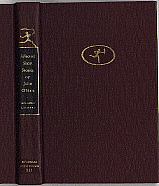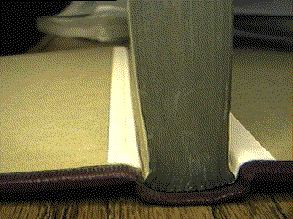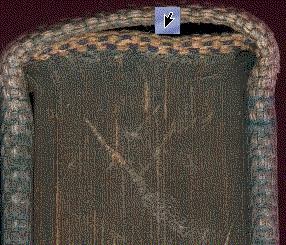
Buckam bindings came in a variety of colors—maroon, red, brown, blue, green, and gray with one copy each of pink and yellow reported—but usually just one color per title. One giant edition uncovered by John Krygier came in a shocking chartreuse. (Put on a pair of sunglasses and click here to see it.)
The regular-sized buckrams show a torchbearer inscribed in an oval. Click the image for a blowup. A couple of varieties of this torchbearer exist, as seen on the Buckram Binding Varieties page.
The ML number of the book usually appears on an impressed label at the base of the spine. The label's a bit difficult to read in the scan; it says "BUCKRAM REINFORCED 211" where "211" is the ML# for this particular title. Click the image for a blowup shot.
The pebbly finish is resistent to soiling (and as a lucky aside gives you a firmer grip on the book).

This image shows the book with the block held up over the covers. You can see the edge of a white cloth reinforcing strip to the left and right of the book block. The strip is about an inch wide on this book, and covers the entire spine. This gives added strength to the book's most sensitive areas, the front and rear hinges.
All that extra reinforcing made the book last a lot longer in general circulation.


Modern Library tried to introduce buckrams in 1928 to sell them to the library market. They had the design of a type 4 binding, including the Bernhard endpapers and logo, but the boards were extremely hard and covered in blue buckram. (See the section on transitional binding variations for a view of what the "standard" type 4 looks like.)
Much thicker than the covers on the standard issues of the day and even denser than either the balloon cloth issues of the 30's or even the ubiquitous Blumenthals of the 40's and 50's, these puppies were made to take a lot of abuse.

Unlike the 60's buckrams, there was no indication of the "special" class of these books; the spine printing was the same as the regular issues of the period. (As an aside, the color wasn't all that fast, and the spines faded to an orangy brown over not too long a time.)
The experiment failed - libraries weren't buying these guys, so Modern Library abandoned the experiment in 1929 and the books were remaindered.